Ship Traveling In The North Sea Films One Of The Largest Waves Ever
A tsunami is a series of waves created when a large volume of ocean water is flashed on a large scale. Earthquakes and large geological movements above or below the water surface, volcanic eruptions and meteorite impacts are all capable of causing tsunamis. The disastrous consequences of tsunamis can be enormous, killing by drowning in the water to hundreds of thousands of people in a few hours.
Tsunami battles can form when the sea floor, suddenly deformed vertically, displaces the amount of water above it. Such large vertical movements of the Earth's crust can occur at the edge of the continental plate. Earthquakes are caused by special collisions or create tsunamis. When an ocean plate collides with a continental plate, it sometimes moves the edge of the continental plate downwards. Finally, the excessive pressure applied to the edge of the array made it snaps back to create waves that hit the Earth's crust, causing the earthquake to occur, called the earthquake Bottom of the sea.
The seabed landslides (sometimes due to earthquake causes) as well as volcanic collapse can also shock the water column, causing sediments and rocks to slide down the mountain slopes to the seabed. Similarly, a strong volcanic eruption under the sea can also bounce off a column of water to form a tsunami. The waves are formed when the displacement of water moves under the influence of gravity to regain balance and spread out across the ocean like ripples on the pond surface.
In the 1950s it was discovered that large tsunamis can occur from landslides, volcanic eruptions and meteorite collisions. These phenomena caused a large amount of water to quickly be displaced, when the energy from an asteroid or an explosion moved into the water where the collision occurred. Tsunamis that appear from these causes, unlike tsunamis caused by earthquakes, often quickly disintegrate and rarely spread to the coast too far because of small events. These phenomena can cause large seismic waves in only one area. However, an extremely large landslide can cause a massive tsunami to affect the entire ocean.
The gods are very different depending on the wave type: they contain tremendous energy, spread at a high speed and can exceed large distances across the ocean with only very little energy loss. A tsunami can cause damage on the coast thousands of kilometers away where it arises, so we can have many hours of preparation since it's formed until it hits a beach, it appeared a long time after seismic waves formed from where the incident occurred. The energy per meter is long in the wave proportional to the inverse of the distance from the source.
Even a separate tsunami can involve a series of waves of different heights. In large waters, tsunamis have a very long cycle (the time for the next wave to reach a point after the previous wave), from several minutes to several hours, and the length of the wave is hundreds of kilometers. This is very different from the waves formed from normal wind on the ocean surface, they usually have a period of about 10 seconds and a wave length of 150 meters.
The following signs often foretell a tsunami: Feel the earthquake. If you feel that the ground is shaking so hard that it can't stand, it's likely that a tsunami will happen. Gas bubbles that float on the water make us feel like the water is boiling. The water in the waves is unusually hot. Water smells of rotten eggs (hydrogen sulfide gas) or gasoline and oil odors. Water causes itchy skin. Hearing an explosion sounded like: a jet engine's noise, the noise of a helicopter rotor, or a whistling sound. The sea came back remarkably. Dark clouds filled the sky. Red light streaks on the horizon. When the tsunami hits the shore, there will be a roar like a train approaching. Millions of seagulls fly against the sea. Many countries when there are tsunamis, often have warning sirens howling.
-
 2:29
2:29
Licet Studios
3 years agoShip in Storm | Tanker Facing Monster Waves in North Atlantic!
6 -
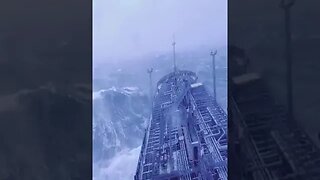 0:13
0:13
Planet-Today.com
1 year agoShip navigates through massive waves in Atlantic Ocean
4 -
 1:14
1:14
Licet Studios
3 years agoShip in Storm | Cruise Ship Climbing Up Big Waves
6 -
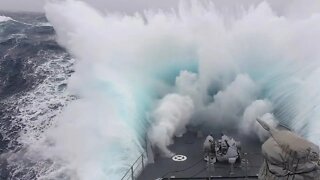 0:22
0:22
Licet Studios
3 years agoShip in Storm | WARSHIP Hit By Massive Wave Near Antarctica | #Shorts
19 -
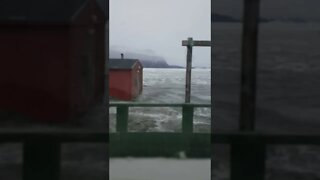 6:09
6:09
Licet Studios
3 years agoUncut: Greenland Tsunami (First Wave to Largest Wave in 6 mins.)
399 -
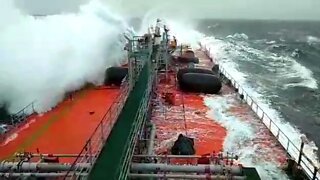 0:43
0:43
Licet Studios
3 years agoShip in Storm | MONSTER WAVE Destroys Bridge Of Tanker
38 -
 7:59
7:59
SweetHomeStAugustine
9 months agoCargo Ship On Fire in the North Sea
2021 -
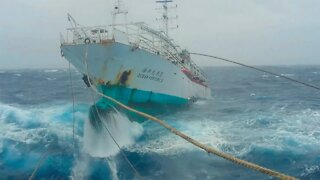 1:59
1:59
Licet Studios
3 years agoShip in Storm | Towing A Fishing Vessel Through Massive Waves! (Ran Out Of Fuel)
1 -
![Ship in Storm | WARSHIP Hit By Monster Wave Near Antarctica [4K]](https://hugh.cdn.rumble.cloud/s/s8/1/d/I/3/5/dI35f.0kob-small-Ship-in-Storm-WARSHIP-Hit-B.jpg) 0:58
0:58
Licet Studios
3 years agoShip in Storm | WARSHIP Hit By Monster Wave Near Antarctica [4K]
33 -
![[4K] Learning Lesson Video: Tsunami: How its formed, Largest in a history, What to do](https://hugh.cdn.rumble.cloud/s/s8/1/B/w/E/y/BwEyj.0kob-small-4K-Learning-Lesson-Video-Ts.jpg) 3:59
3:59
slavatsarev
1 year ago $0.01 earned[4K] Learning Lesson Video: Tsunami: How its formed, Largest in a history, What to do
141